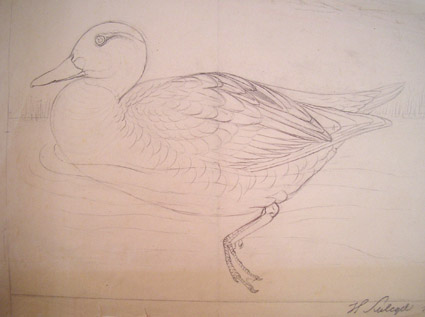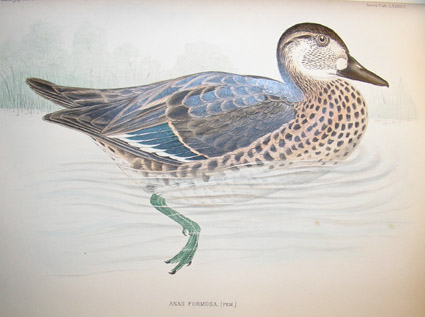january 2012 - Malacological Library of Monsieur Léopold Pons d'Hauterive

One
of the advantages of being in France is that from time to time (not often) you
can be offered a local French historical collection of books. In this case it
was the malacological library of Léopold Pons d'Hauterive. I could not find
any birth or decease dates, but he was active in the second half of the 19th
century, a time in which French malacology flourished as never before (and
perhaps never after). In that period two important movements were opposing
each other. There were people like Crosse and Fischer who were responsible for
the Journal de Conchyliologie, and a group centred around ''la bête noire''
of 19th century French malacology, Bourguignat. He had a specific view on how
molluscan species should be defined. In short his theory was that each species
should be separated by at least three different characters. This gave rise to
a multitude of species descriptions. Sometimes each local lake in France would
have their own endemic fauna.
As
the group around Bourguignat needed their own society and journal, the
Bulletins de de la Société Malacologique de France, together with the
Annales and the Revue were founded by 12 French Malacologists in 1884.
In
the collection there was a small pamphlet in the same format as the Bulletin,
stating that in a meeting on 28 November 1883 the board was assigned as
follows: President: Servain, Vice-Pres.: Locard, Secr.: Mabille and De
Rochebrune, Secretary-General: Bourguignat. There were 34 members, 17 of which
were French, among whom was Léopold Pons d'Hauterive, from Espalion (in the
region of Aveyron).
Although
Pons d'Hauterive was very interested in malacology, he was not one of the
important figures of the time. As far as I could ascertain he described only
one species: Helix liypsellina.
Unfortunately,
just before posting this news item, more than half of the collection has been
sold to one of my customers; including sets of the Bulletin and the Annales.
But
for instance the very interesting set of the Revue Biographique de la Société
Malacologique de France still is for sale. A collection of portraits and
biographies/bibliographies of French malacologists including: Servain, Locard,
Mabille, Rochebrune, Bourguignat, Fagot, Saint-Simon, and Ray, Letourneux,
C.M.F. Ancey, J.M.L.F. Ancey, Poirier, Reynès, Jousseaume, Massot, Lamarck,
Draparnaud, and Pechaud.
The
revue is a very important source for finding biographical and bibliographical
data on some of the lesser known French 19th century malacological authors
(and some of the better known as well). The portraits are well executed and
were specially made for the revue. For a few malacologists these portraits are
the only ones existing (or at least available).
Furthermore
about 20 other items from this collection still remain, which can be found in
my next malacology catalogue to be issued in February.
DECEMBER 2011 - Acquisition of the Library of the Zoological Museum Amsterdam

History of the Museum
The foundation for the Zoological Museum Amsterdam was laid when the gentlemen Westerman, Werlemann, and Weismuller founded the Zoological Society 'Natura Artis Magistra' in May 1838. Due to lack of live animals, the new Society board, formed by the three aforementioned gentlemen, started by buying a set of stuffed animals. The first collections of the Society's Zoological Museum were mainly educational and did not meet the requirements of present-day scientific collections. This situation changed in the 1870's. The first, a scientific assistant was employed by the Society (R. T. Maitland). Secondly, a new building was erected in 1872.
In an agreement
between the Municipal University (Gemeente Universiteit) and the Society it
was arranged that the collections of both were united.
The cooperation between University and Society and the shift in ideas about
scientific collecting gave a big impetus to the development of the zoological
museum. Within about a decade, c. 1875-1885, the collection changed from a
show with samples of the beauty of nature to a much larger scientific
collection. Many collections of all groups of animals were received between
1880 and the 1930's, from private persons and institutions from all-over the
world, and especially from the former Dutch colonies (present-day Indonesia,
Surinam, and the Netherlands' Antilles). Important additions included large
samples of natural history items which had been on show on the First
International Trade Exhibition in Amsterdam (1883) and the rich marine
collection of the Siboga-expedition (1899-1900), organized by Max Weber.
During the economic
recession of the 1930's, the Society neared bankruptcy. The idea arose of
selling the more important collection items, like the last Quagga, the Great
Auk with its egg, the Norfolk Island Kaka, and other rare or extinct animals
for which important sums of money could be obtained in the USA. The planned
auction was cancelled when the Municipality of Amsterdam and the Province of
North-Holland bought all possessions of the Society in 1939. The entire
zoological collection and library came to the Municipality, and so entirely
became part of the Municipal University.
Increased availability of money after World War II and a rapidly growing
number of interested biology students led to a new boom in development of the
zoological collections from the 1950's to the 1970's. The collections became
better housed: originally scattered over at least 10 old buildings mostly in
and around the zoo, the museum gradually concentrated in a smaller number of
more suitable buildings, especially after the change from Municipal University
to the governmentally financed University of Amsterdam.
Recently the University stopped funding the Amsterdam Museum, and the collections and most of the staff moved to the National Museum of Natural History in Leiden. The library was dismantled. I managed to obtain what was left of the library of the Zoological Museum. The older books were donated to the Artis library (Amsterdam), the National Natural History Museum (Leiden) took those books that were wanting in their library, and the former employees could buy books from what was left. I subsequently bought what remained. Although much thinned out, there were still 3000 books left. The collection was especially rich in books on vertebrates (Birds, Mammals, Fishes and to a lesser extend reptiles and amphibians). In the invertebrate section the collection is especially rich in fields like Crustacea and Annelida, but less so in Malacology (much sold to previous employees) and Entomology, as the museum staff had access to the library of the Nederlandse Entomologische Vereniging (which is among the richest entomological libraries in the world).
But still an very interesting addition to my stock, which includes many hard to find titles. The next catalogues including books from the library of the Zoological Museum of Amsterdam are: Malacology, Marine Mammals, and Invertebrates (including the large and interesting collection of Polychaete books and many hundreds of Polychaete reprints). These will be issued in February. Others in preparation are: Entomology, Crustacea and Terrestrial Mammals.
FIRST COLOURED COPY OF SWAMMERDAM’S HISTORIA INSECTORUM GENERALIS

We recently obtained the following book:
Swammerdam, J., 1669 (1st ed.). Historia Insectorum Generalis, ofte Algemeene Verhandeling van de Bloedeloose Dierkens; [26], 168, 48 p., 13 (12 folded) hand coloured engraved plates, 2 vignettes, 1 folded table, contemporary (or slightly later) half vellum with marbled boards (boards somewhat worn). One small hole in first blank end paper (repaired). Some plates browned. Some very slight scattered foxing (mostly in first few pages). Library stamp at rear of title-page ''Grosherzogliche Bibliothek Neustrelitz'' (with discard stamp dated 1950). This copy includes pages 11-12 of the ‘’second part’’, which is like a title-page for his chapter on insect classification, and is according to Schierbeeck (1946: page 228) often missing.
Jan Swammerdam (1637-1680) studied medicine at Leiden University and developed an interest in biological research, especially in physiology and entomology. Although Swammerdam died at a very early age, he certainly is one of the most important Dutch scientists of the 17th century.
Together with Ephemeri vita of afbeeldingh van ‘s Menschen Leven… (1675), the Historia Insectorum Generalis is the only entomological work by Swammerdam that was published during his lifetime.
A work of great scientific merit. In this work Swammerdam laid the foundation of modern insect-classification, which still rests to a great extent upon the developmental history of insects. He also proved wrong almost everything then believed about insects. Since Aristotle, the theory on insects was based on three suppositions, insects lack internal anatomy, they originate by spontaneous generation and they develop by metamorphosis. The idea of metamorphosis was that a sudden and total change from one kind of creature into another.
The above works by Swammerdam demonstrate his mastery to observe, describe and depict (with the primitive means available at his time) the most complicated details of the, often minute, animals he investigated.
I am quite happy to be able to offer the very rare first edition (in Dutch) of this book which is considered, together with the works of Redi and Malpighi, to be the starting point of modern entomology and microscopy. The first edition was written in Dutch; there were later editions in French (1682, 1685) and Latin (1685, 1693, 1733 & 1755).
This copy has all 13 plates, the two vignettes and three capitals hand coloured. No coloured copies of this book are known. At least Landwehr does not mention it in his book ''Studies in Dutch books with coloured plates published 1662-1875: Natural history, topography and travel, costumes and uniforms''. And further research in library and sale catalogues did not reveal any reference to coloured copies of this book. In fact very few copies of the first edition have been offered the last 20 years, and it seems rarer than later French and Latin editions.
In this particular case I believe that the colouring was done 76 years after the appearance of the book, as underneath the first plate there is the following inscription in an old hand, and in the same yellow colour as the plate border: 1745 No. 5 (see photograph). The meaning of ‘’No. 5’’ is not clear. So if in strict sense the colouring is not contemporary, it is certainly not recent as it was done 264 years ago.
DECEMBER 2007 - REMOVAL TO BRITTANY (FRANCE)


I will officially move from the Netherlands to Brittany on December 15 (2007). From that date I will be exclusively working from my new address: Porzh Hervé, 22780 Loguivy Plougras, Brittany, France.
Any e-mails sent to the Netherlands will not be lost, but will take more time to reach me as they will be forwarded to me as soon as possible (which is not always the same day).
I am now based in the rural countryside were the pace of life is slower (so is my PC - no ADSL!). Here I hope to put on sale the remaining several thousand titles that are still to be added to my database. An important advantage is the increase of space to store my books.
The first catalogue issued from my new premises will be one on Botany with over 850 titles. The one after will be a new Malacology catalogue. Next year, when all the books are here and I am firmly settled, I hope to be of even better assistance to you and I will hope to find you just that book that isn't for sale anywhere else!
With best (bibliophile) wishes,
Hermann Strack
























